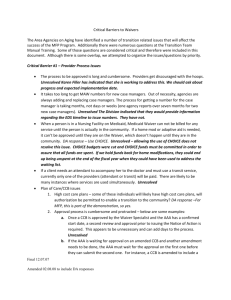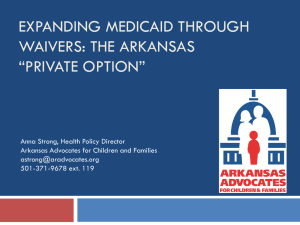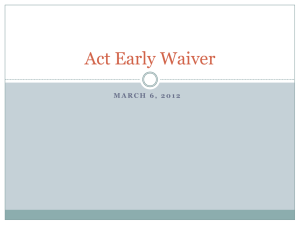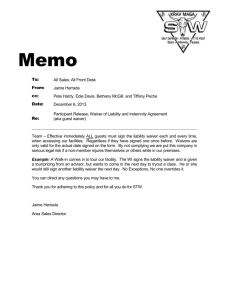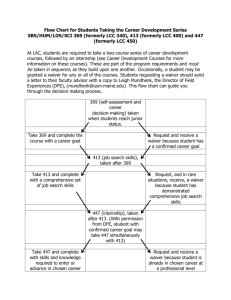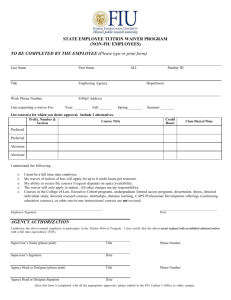Transition Issues Identified by AAAs
advertisement
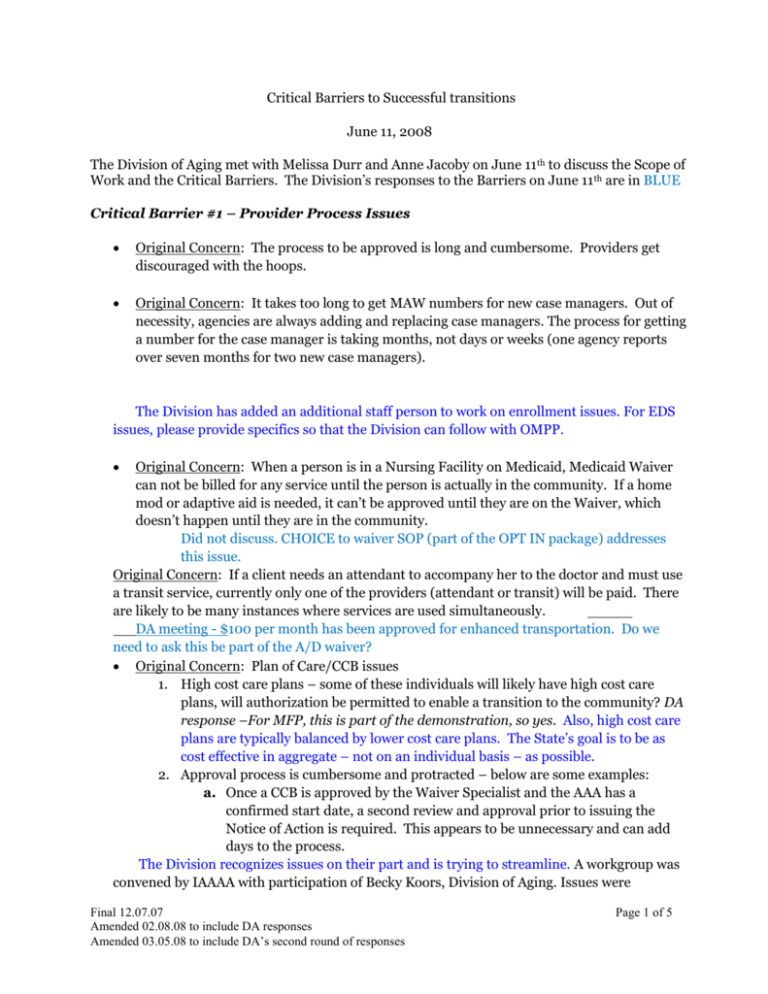
Critical Barriers to Successful transitions June 11, 2008 The Division of Aging met with Melissa Durr and Anne Jacoby on June 11th to discuss the Scope of Work and the Critical Barriers. The Division’s responses to the Barriers on June 11 th are in BLUE Critical Barrier #1 – Provider Process Issues Original Concern: The process to be approved is long and cumbersome. Providers get discouraged with the hoops. Original Concern: It takes too long to get MAW numbers for new case managers. Out of necessity, agencies are always adding and replacing case managers. The process for getting a number for the case manager is taking months, not days or weeks (one agency reports over seven months for two new case managers). The Division has added an additional staff person to work on enrollment issues. For EDS issues, please provide specifics so that the Division can follow with OMPP. Original Concern: When a person is in a Nursing Facility on Medicaid, Medicaid Waiver can not be billed for any service until the person is actually in the community. If a home mod or adaptive aid is needed, it can’t be approved until they are on the Waiver, which doesn’t happen until they are in the community. Did not discuss. CHOICE to waiver SOP (part of the OPT IN package) addresses this issue. Original Concern: If a client needs an attendant to accompany her to the doctor and must use a transit service, currently only one of the providers (attendant or transit) will be paid. There are likely to be many instances where services are used simultaneously. DA meeting - $100 per month has been approved for enhanced transportation. Do we need to ask this be part of the A/D waiver? Original Concern: Plan of Care/CCB issues 1. High cost care plans – some of these individuals will likely have high cost care plans, will authorization be permitted to enable a transition to the community? DA response –For MFP, this is part of the demonstration, so yes. Also, high cost care plans are typically balanced by lower cost care plans. The State’s goal is to be as cost effective in aggregate – not on an individual basis – as possible. 2. Approval process is cumbersome and protracted – below are some examples: a. Once a CCB is approved by the Waiver Specialist and the AAA has a confirmed start date, a second review and approval prior to issuing the Notice of Action is required. This appears to be unnecessary and can add days to the process. The Division recognizes issues on their part and is trying to streamline. A workgroup was convened by IAAAA with participation of Becky Koors, Division of Aging. Issues were Final 12.07.07 Amended 02.08.08 to include DA responses Amended 03.05.08 to include DA’s second round of responses Page 1 of 5 identified AAA and Division. Division has hired three staff for the waiver unit. Becky Koors and another Division staff member,LaVelle (?) will be going to AAAs to provide technical assistance on AAA issues. b. c. If the AAA is waiting for approval on an amended CCB and another amendment needs to be done, the AAA must wait for the approval on the first one before they can submit the second one. For instance, a CCB is amended to include a home modification. Before the approval is received, the provider has staffing issues and there needs to be a change in providers. The client does without service until both the original amendment and the second amendment is approved. That could easily take months. See above. d. Prior authorization for clients who need equipment or modification before returning to the community is a Catch-22 and it may interfere with the ability to transition an individual to the community. On the original CCB, the AAA must identify a provider. By the time the approval is given, the provider may no longer have a staff person available for that client. The AAA then has to do an amendment and hope it gets approved while the new provider’s staff is available. It would help if we could put “provider to be determined”. Division will investigate to determine if INsite requires a name. Discussion of how widespread the problem is. Jacoby will have her staff investigate and send information to the Board and Karen Filler. Critical Barrier #2 – Provider Availability and Rate Issues Original Concern: In certain areas of the state, particularly the rural areas, there are not enough traditional in-home service providers – homemaker, attendant, home health aid and nursing. In other rural areas there may be several providers but none of them consistently provide the services. There are two possible reasons for this: 1. The MAW rates for are not competitive with Medicare and Medicaid PA. Providers do not feel they can afford to send staff to the rural areas. Also, if a provider has a staff shortage (which happens frequently), Medicare and Medicaid PA clients are preferred and MAW cases are not seen. 2. If there are several providers available in a rural area and the clients have a choice of providers, no one provider has enough clients to hire staff in the area to cost effectively serve the clients. More competitive rates would help. Another solution would be allowing the AAA to select one provider to serve in these difficult to serve areas. The Division is raising rates on July1 and has asked for feedback from AAAs regarding rates and providers after July 1. Original Concern: There are two problems with the rate structure for Adult Foster Care and Assisted Living Final 12.07.07 Amended 02.08.08 to include DA responses Amended 03.05.08 to include DA’s second round of responses Page 2 of 5 1. Clients that receive SSI only have are allowed a $52 Personal Needs Allowance. This is the same amount that a Nursing Facility resident receives yet the AFC/AL client must purchase their medications and other personal items provided by the Nursing Facility or not needed by a Nursing Facility resident such as money for entertainment – going out to eat or to a movie. To expect the provider to pay for these extra expenses is not reasonable since they are already receiving a lower Room and Board payment because of the deduction of the Personal Needs Allowance. 2. Clients that have incomes at or near the 300% SSI, can have as much as $1200 left after paying their monthly Room and Board. Assuming they have funded a Funeral Trust (or have a life insurance policy to cover funeral) they do not have $1200 worth of expenses each month. After a few months, they will be over the resource amount allowed under Medicaid and would lose their Medicaid status until they spent down their resources. An individual could continuously go in and out of Medicaid eligibility. A possible solution would be to treat AFC/AL more like a Nursing facility and have a liability based on the client’s income and have a PNA that is adequate to meet their needs – meds, phones, etc. or allow MAW to include medication. Megan Ornellas stated that this will be changing. Original Concern: There needs to be more recruiting of new providers, particularly AFC providers because they are not in every PSA. AFC is critical to meeting the MFP criteria. –. AFC/AL is still concern. AFC/AL is reviewed weekly and has a priority code. Critical Barrier #3 – MFP Process Issues Original Concern: We were informed that after a participant had been on the MFP for 365 days they would be guaranteed an A& D or TBI waiver slot. Since MAW slots are not always open, how will that be guaranteed? DA response – The Division of Aging has reserved slots for each year. We expect to transition 216 the first year, so we have reserved 216 slots. We will continue to do the same each subsequent year to assure slots are available. Original Concern: If a person needs to leave MFP to move to AL is he or she guaranteed a waiver slot or will they go back to NF? Although we received a Yes, response, the written response also says “FIND OUT”. DA response – The Division of Aging looks to MFP as a priority, and AL already has a priority code designation. Should someone need to leave the community and go to assisted living, yes, they will receive priority in receiving a slot. Original Concern: Transition Team – there are numerous questions about the make up of the transition team. Two required definitive answers in order for the AAAs to move forward. If joint visits are required, AAAs must be able to bill for the time of both team members Most of these activities would fall into the Administrative category outlined on the first page of the Scope of Work. Only one billing for case management per visit. 1. AAAs need to be allowed to establish Transition Teams based on the number and location of transitions within the area. Agencies need to be allowed to have more Final 12.07.07 Amended 02.08.08 to include DA responses Amended 03.05.08 to include DA’s second round of responses Page 3 of 5 than one designated team and teams serving less populated counties need to be allowed to carry other cases. DA response – AAAs can have more than one transition team. . .they must have, however, at least one specialist and one nurse. HOWEVER, for the Division of Aging to adequately provide access to the MDSHC system (usernames), disseminate data, obtain reporting information, etc., it is imperative that each AAA identify who their team(s) will be, and not add exponentially. Original Concern: Medicaid Eligibility questions that require a definitive answer in order to move forward: 1. Will MFP program participants complete Medicaid eligibility redetermination just as they would if they were not enrolled in the MFP? DA response – Yes, though DA considers MFP priority When a person becomes MFP participant are they protected from losing Medicaid eligibility? The assumption of Medicaid eligbility for the first 365 days holds. The ‘assessment’ that will occur thirty days before day 366 will determine if the individual is eligible for the waiver and possible spend down. The AAAs will collect that financial information and the number and status of those individuals will be monitored to determine how large an impact this has and future changes to the waiver. Original Concern: At the training it was stated that the transition team needs only to speak with the potential participant and/or their legal guardian. We inquired about POA's/family and were told that they don't have rights to be able to make decisions for these people. While legally that is true, successful transitions must include family/friends that provide the informal support and are typically listed as the contact person for the PERS. DA response – Transition specialist and nurse must speak with whomever the participant deems appropriate to assist in transition planning. The team consists of the participant, specialist, nurse, and anyone else the participant wants to provide input. Legal guardians, if the participant has one, should also be included. Original Concern: The inability of some participants to pay their first month’s rent in order to secure housing will be a barrier. We understand that CHOICE dollars can be used, but most agencies still have waiting lists for CHOICE services. DA response – There will also be other sources of funding available, such as SSBG, etc. IAAAA comments to DA’s first response: This response does not resolve the issue for all areas. Many AAAs received SSBG cuts and now have waiting lists for SSBG. To be successful, transitions can not be dependent on discretionary funding that may already be obligated/spent and can change from year to year. DA’s second response: What do AAAs currently do in this situation? Again, the MFP transitions, in process, differ none from traditional transitions. The Housing Task Force that’s been established will be working on methods by which to reduce and/or alleviate first month’s rent, if possible, for some participants. Not discussed. Transition funds are now $1500 for A&D waiver. The Division has asked that IAAAA track through the reporting system how the funds are used in order to make changes to the waiver in the future. Final 12.07.07 Amended 02.08.08 to include DA responses Amended 03.05.08 to include DA’s second round of responses Page 4 of 5 Original Concern: There are numerous INsite related billing issues. AAAs must have clear way to bill prior to the moving forward. DA response – A billing “protocol” can be created to assist in this process. Remember, though, that billing will not change as it relates to transition on the whole. . .there will be codes specific to MFP, but targeted case management will still be billed prior to discharge, and “MFP A/D” or “MFP TBI” waiver will be billed after the first year. Not discussed Final 12.07.07 Amended 02.08.08 to include DA responses Amended 03.05.08 to include DA’s second round of responses Page 5 of 5
